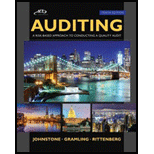
Auditing: A Risk Based-Approach to Conducting a Quality Audit
10th Edition
ISBN: 9781305080577
Author: Karla M Johnstone, Audrey A. Gramling, Larry E. Rittenberg
Publisher: South-Western College Pub
expand_more
expand_more
format_list_bulleted
Question
Chapter 8, Problem 26MCQ
To determine
Introduction:Sampling Interval technique is used by the Auditor to arrive at number of sampling units and segregate these sampling units in
To choose:The option which represents the calculation of sampling interval.
Expert Solution & Answer
Want to see the full answer?
Check out a sample textbook solution
Students have asked these similar questions
In December 2018, Crescent Fabrication established its predetermined overhead rate for jobs produced during 2019 using the following cost estimates: overhead cost of $300,000 and direct materials cost of $250,000. Determine the predetermined overhead rate for 2019. Need answer
Tutor Need Your Help
I am looking for help with this general accounting question using proper accounting standards.
Chapter 8 Solutions
Auditing: A Risk Based-Approach to Conducting a Quality Audit
Ch. 8 - Prob. 1TFQCh. 8 - Prob. 2TFQCh. 8 - Prob. 3TFQCh. 8 - Prob. 4TFQCh. 8 - Prob. 5TFQCh. 8 - Prob. 6TFQCh. 8 - Prob. 7TFQCh. 8 - Prob. 8TFQCh. 8 - Prob. 9TFQCh. 8 - Prob. 10TFQ
Ch. 8 - Prob. 11TFQCh. 8 - Prob. 12TFQCh. 8 - Prob. 13TFQCh. 8 - Prob. 14TFQCh. 8 - Prob. 15MCQCh. 8 - Prob. 16MCQCh. 8 - Prob. 17MCQCh. 8 - Prob. 18MCQCh. 8 - Prob. 19MCQCh. 8 - Prob. 20MCQCh. 8 - Prob. 21MCQCh. 8 - Refer to Exhibit 8.6. Assume a 5% risk of...Ch. 8 - Prob. 23MCQCh. 8 - Prob. 24MCQCh. 8 - Prob. 25MCQCh. 8 - Prob. 26MCQCh. 8 - Prob. 27MCQCh. 8 - Prob. 28MCQCh. 8 - Prob. 29RSCQCh. 8 - Prob. 30RSCQCh. 8 - Prob. 31RSCQCh. 8 - Prob. 32RSCQCh. 8 - Prob. 33RSCQCh. 8 - Prob. 34RSCQCh. 8 - Prob. 35RSCQCh. 8 - Prob. 36RSCQCh. 8 - Prob. 37RSCQCh. 8 - Prob. 38RSCQCh. 8 - Prob. 39RSCQCh. 8 - Prob. 40RSCQCh. 8 - Prob. 41RSCQCh. 8 - Prob. 42RSCQCh. 8 - Prob. 43RSCQCh. 8 - Prob. 44RSCQCh. 8 - Prob. 45RSCQCh. 8 - Prob. 46RSCQCh. 8 - Prob. 47RSCQCh. 8 - What is stratification? Distinguish between...Ch. 8 - Prob. 49RSCQCh. 8 - Prob. 50RSCQCh. 8 - Prob. 51RSCQCh. 8 - Prob. 52RSCQCh. 8 - Prob. 53RSCQCh. 8 - Prob. 54RSCQCh. 8 - Prob. 55RSCQCh. 8 - Prob. 56RSCQCh. 8 - Prob. 57RSCQCh. 8 - Prob. 58RSCQCh. 8 - Prob. 59RSCQCh. 8 - Prob. 60RSCQCh. 8 - Prob. 61RSCQCh. 8 - Prob. 62RSCQCh. 8 - Prob. 63RSCQ
Knowledge Booster
Similar questions
- Accounting?arrow_forwardCalculate the depreciation for Year 1 using the units-of-production (activity-based) depreciation method. 40 service trucks were purchased at a cost of $38,000 each. Each truck is estimated to be driven a total of 80,000 miles and then be sold for an estimated $8,000. In Year 1, the trucks were driven 1,120,000 miles.arrow_forwardXavi Industries has two production departments with distributed production overhead of $15,000 for Dept. A and $9,000 for Dept. B. Dept. A uses a total of 6,000 labor hours, while Dept. B uses 3,000 labor hours. Assuming labor hours as the allocation base, what is the overhead rate for Dept. A? a. $2.50 b. $1.80 c. $3.00 d. $2.00 e. $2.75 answerarrow_forward
arrow_back_ios
SEE MORE QUESTIONS
arrow_forward_ios
Recommended textbooks for you
 Auditing: A Risk Based-Approach (MindTap Course L...AccountingISBN:9781337619455Author:Karla M Johnstone, Audrey A. Gramling, Larry E. RittenbergPublisher:Cengage Learning
Auditing: A Risk Based-Approach (MindTap Course L...AccountingISBN:9781337619455Author:Karla M Johnstone, Audrey A. Gramling, Larry E. RittenbergPublisher:Cengage Learning Auditing: A Risk Based-Approach to Conducting a Q...AccountingISBN:9781305080577Author:Karla M Johnstone, Audrey A. Gramling, Larry E. RittenbergPublisher:South-Western College Pub
Auditing: A Risk Based-Approach to Conducting a Q...AccountingISBN:9781305080577Author:Karla M Johnstone, Audrey A. Gramling, Larry E. RittenbergPublisher:South-Western College Pub Essentials of Business Analytics (MindTap Course ...StatisticsISBN:9781305627734Author:Jeffrey D. Camm, James J. Cochran, Michael J. Fry, Jeffrey W. Ohlmann, David R. AndersonPublisher:Cengage Learning
Essentials of Business Analytics (MindTap Course ...StatisticsISBN:9781305627734Author:Jeffrey D. Camm, James J. Cochran, Michael J. Fry, Jeffrey W. Ohlmann, David R. AndersonPublisher:Cengage Learning

Auditing: A Risk Based-Approach (MindTap Course L...
Accounting
ISBN:9781337619455
Author:Karla M Johnstone, Audrey A. Gramling, Larry E. Rittenberg
Publisher:Cengage Learning

Auditing: A Risk Based-Approach to Conducting a Q...
Accounting
ISBN:9781305080577
Author:Karla M Johnstone, Audrey A. Gramling, Larry E. Rittenberg
Publisher:South-Western College Pub

Essentials of Business Analytics (MindTap Course ...
Statistics
ISBN:9781305627734
Author:Jeffrey D. Camm, James J. Cochran, Michael J. Fry, Jeffrey W. Ohlmann, David R. Anderson
Publisher:Cengage Learning